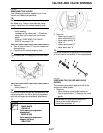
VALVES AND VALVE SPRINGS
5-17
EAS24280
REMOVING THE VALVES
The following procedure applies to all of the
valves and related components.
TIP
Before removing the internal parts of the cylin-
der head (e.g., valves, valve springs, valve
seats), make sure the valves properly seal.
1. Check:
• Valve sealing
Leakage at the valve seat → Check the
valve face, valve seat, and valve seat
width.
Refer to “CHECKING THE VALVE
SEATS” on page 5-19.
▼▼▼▼▼▼▼▼▼▼▼▼▼▼▼▼▼▼▼▼▼▼▼▼▼▼▼▼▼▼
a. Pour a clean solvent “a” into the intake and
exhaust ports.
b. Check that the valves properly seal.
TIP
There should be no leakage at the valve seat
“1”.
▲▲▲▲▲▲▲▲▲▲▲▲▲▲▲▲▲▲▲▲▲▲▲▲▲▲▲▲▲▲
2. Remove:
• Valve cotters “1”
TIP
Remove the valve cotters by compressing the
valve spring with the valve spring compressor
and the valve spring compressor attachment
“2”.
3. Remove:
• Upper spring seat “1”
• Inner valve spring “2”
• Outer valve spring “3”
•Valve “4”
• Lower spring seat “5”
• Valve stem seal “6”
TIP
Identify the position of each part very carefully
so that it can be reinstalled in its original place.
EAS24290
CHECKING THE VALVES AND VALVE
GUIDES
The following procedure applies to all of the
valves and valve guides.
1. Measure:
• Valve-stem-to-valve-guide clearance
Out of specification → Replace the valve
guide.
Valve spring compressor
90890-04019
YM-04019
Valve spring compressor
attachment
90890-01243
Valve spring compressor
adapter (26 mm)
YM-01253-1
• Valve-stem-to-valve-guide clearance =
Valve guide inside diameter “a” -
Valve stem diameter “b”


















